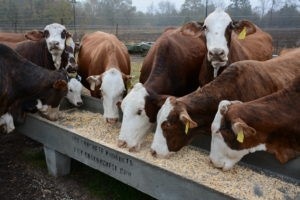Producers should consider environment, location and stocking rates when it comes to internal parasites.
November 28, 2018

Following recommendations to treat the threat of internal parasites in cattle herds is a proactive way to protect production gains and, therefore, profits, Texas A&M AgriLife Extension Service beef cattle specialist Dr. Jason Banta said.
Banta said internal parasites can cause reduced appetite, reduced digestion and absorption of nutrients, lessened immune function, reduced performance such as lower calf and yearling growth rates and lower pregnancy rates in cows.
“Deworming is just one of those proactive management strategies ranchers perform to avoid the consequences of parasite infection,” he said. “If a producer is seeing signs of infection, we’ve already lost production, and that leads to reduced income.”
Banta said it’s important for producers to consider their environment and stocking rates when it comes to internal parasites. Recommendations for the northern half of the U.S. are vastly different from the southern half. Similarly, parts of Texas that receive more rainfall — like east Texas — face more challenges when it comes to parasites, he said.
Parasite eggs spread through cow manure, and rainfall allows larvae to emerge from manure piles and crawl up blades of grass, where they are consumed by cows, Banta explained.
“Because of the high rainfall, producers in east Texas generally will need to deworm their herds twice a year: once in late May or early June and again in November or December,” he said. “Producers in central parts of Texas may only need to deworm once during summer, whereas producers in some parts of the panhandle and west Texas may not need to deworm at all. Generally, the more rainfall we have, the more we’ll have problems with internal parasites because they need moisture to propagate.”
Stocking rates also factor into deworming recommendations, Banta said. For instance, internal parasites are a bigger problem when cow/calf pairs are stocked at three acres per pair versus 15 or 100 acres per pair, he noted.
“When stocking rates rise, so does the chance those cows will graze areas where they will be exposed to parasites,” he said.
Banta said producers typically treat cattle for gastrointestinal roundworms with products administered as pour-ons or injectables. He said the main culprits, Ostertagia ostertagi and Haemonchus placei, can be treated with macrocyclic lactones such as Eprinex, Cydectin, Dectomax and Long Range.
“Those products all have excellent efficacy,” he said. “If efficacy is similar, it is useful to consider slaughter withdrawal times, flammability concerns, persistent activity and ease of administration when comparing products. ... It is always important to check the label, because slaughter withdrawal times may be different for the same brand depending on if it is an injectable or pour-on.”
Cooperia species can be a problem in cattle that are less than a year old. The “white dewormers” like Safeguard, Synanthic and Valbazen are probably the best choices to control this group of worms, he said. When cattle get older, they generally develop good immunity to this group.
Some producers will deworm calves with both a white product and a macrocyclic lactone. The macrocyclic lactone provides control against a wider range of parasites as well as some residual control, Banta said.
“It’s always best to have a conversation with your local veterinarian or beef cattle expert for input on specific recommendations for their environment, stocking rates and type of operation,” Banta said.
You May Also Like


.png?width=300&auto=webp&quality=80&disable=upscale)
